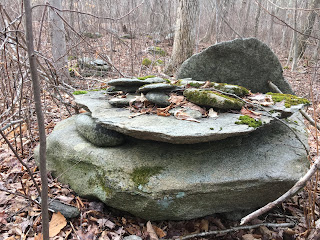“Previous
to the discovery of the beautiful meadows at the great bend of the Tunxis
River...nothing was known of the territory west of the Talcott range, except as
it may have been penetrated rarely by a few daring hunters and explorers. When
a treaty was ratified with the Indians, in 1650, and the lands opened for
settlement, two well-defined trails
led westward through the woods, one practically where the first colonial road
was built from Chippen's Hill to Farmington; the other southwestwards crossing
the mountain, west of the sewer beds diagonally; crossing the present town of
Wolcott also in a southwesterly direction; thence through the southeast corner of Plymouth to Waterville,
then in the territory known as Mattatuck. Over this trail to Mattatuck the
early settlers of Waterbury travelled, taking the first millstones ever used in
that town on horseback. At the reservoir on South Mountain, southwest of the
Allen place, near the south end of the pond, and not far from the town line, the trail crossed what was then a swamp
over a causeway of loose stones and earth, the nearest approach to a roadway
ever made by the aborigines. The trail crossed Mad River near the beaver
dam which then existed near the south end of the Cedar Swamp reservoir,
continuing southwesterly, the present highway following it for some distance...”
Bristol, Connecticut: "in
the Olden Time New Cambridge", which Includes Forestville
Page 9
SW Trail, well defined??
"This is a beautiful trail, and so long as you stay close to the brook, it's a relatively easy hike."
Above photo used with the kind permission of (the excellent):
"Raechel Guest's Waterbury Thoughts Blog"
A few original images captured of the "retaining wall" that seems to incorporate Indigenous/Native American Iconography:
A comparison to another stone lined trail in Bethlehem CT, along a brook leading to the "Indian Cave" which is possibly the remnants of a Stone Sweat Lodge/Pesuponck:
Older scanned photos circa 1997:
Before localized flooding filled in the "Plunge Pool:"




























































